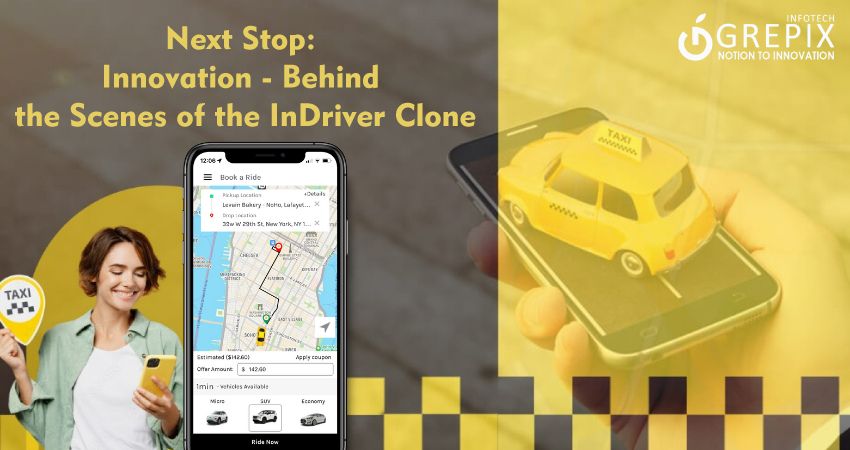Next Stop: Innovation - Behind the Scenes of the InDriver Clone
In this post, we dive deep into the mechanics and philosophy behind the InDriver clone, a groundbreaking approach to ridesharing that empowers users like never before. We'll explore how this innovative platform flips traditional ridesharing dynamics on its head by allowing passengers to set their own fares and drivers to bid for their business. This model not only enhances user autonomy but also injects a refreshing dose of competition into the market, potentially leading to better services and lower costs. Join us as we unpack the technology, the strategy, and the vision that make the InDriver clone a fascinating case study in transportation innovation. Whether you're a tech enthusiast, a market analyst, or just curious about the future of ridesharing, this exploration will provide valuable insights into how disruptive technology can redefine industry norms and consumer expectations.
This blog delves into the development of an InDriver clone, a novel ridesharing app that empowers users by allowing passengers to set their own fares and drivers to bid on these offers. This model introduces a competitive market dynamic that can lead to improved services and reduced costs. The post outlines the app's key features like fare negotiation, real-time decision-making, and flexible payment options, along with enhancements such as an AI-driven pricing algorithm and comprehensive safety features. It also discusses the importance of scalable technology infrastructure, effective marketing strategies, and navigating regulatory challenges, all aimed at optimizing the ridesharing experience.
The Genesis of Our InDriver Clone
The journey of our InDriver clone began with a simple, yet powerful observation: the ridesharing market, while revolutionary, had not fully leveraged the potential of consumer choice in its pricing mechanisms. Traditional models often left users at the mercy of opaque algorithms that determined prices during peak hours or in less connected areas. Our vision was to shift this paradigm, to put control back into the hands of those who use the service most—the passengers and drivers.
Inspired by InDriver's real-time bidding model, where passengers propose fares and drivers can accept or counter them, we set out to refine and adapt this concept to better fit our specific market needs and regulatory environments. Our goal was not just to replicate, but to enhance, creating a platform that was more intuitive, more flexible, and more user-friendly, while maintaining the core ethos of user-driven transactions.
As we developed our clone, we encountered various technical and logistical challenges—from integrating a robust geo-mapping service to ensuring a seamless user interface that could handle a live auction environment. Each problem solved brought us closer to a service that wasn’t just a copy, but a significant evolution.
Core Features and Innovations
At its heart, our clone incorporates the essential features that users have come to appreciate in inDriver:
- Price Negotiation: Users can propose fares for their rides, which drivers can either accept or counter, facilitating a fair and transparent pricing mechanism unlike traditional fixed-rate models.
- Real-Time Decision Making: Both drivers and passengers can make real-time decisions, tailored to current demand and personal preferences, which enhances user satisfaction and retention.
- Flexible Payment Solutions: Supporting multiple payment methods, including cash, credit, and in-app wallets, providing convenience and accessibility to a broad user base.However, innovation does not stop at imitation. We've introduced several advancements.
- Enhanced Matching Algorithm: Leveraging AI, our app predicts fare trends and suggests optimal prices to passengers and drivers, balancing affordability with profitable rides.
- Improved Safety Features: With real-time tracking, SOS buttons, and automated trip monitoring, we ensure that safety is paramount.
- Eco-Friendly Options: Reflecting our commitment to sustainability, our app includes options for electric and hybrid vehicles, encouraging eco-friendly travel choices.
Also Read: "Why inDriver Clone App Is the Best Choice for Budget-Friendly Rideshare"
Passenger Features
A most important Partof a taxi booking app. Therefore, we provide the most advanced features for driver.
- Negotiate Fare with Driver: Rider can share his price for the trip with the driver. The driver will accept or can share his offer with the rider.
- Get Driver’s Information: After the driver accepts a ride, a rider can view the driver's details like –name, image and will be able to call and chat with the driver.
- Accept/Decline Offer: The pricing offer from the drivers is up to the riders to accept or reject. Therefore, there is no chance of miscommunication between them.
- Real-time Tracking: Rider will get real-time updates and notifications for ride accepted, estimated time of driver arrival, begin ride, end ride or cancel.
- Become A Driver: After login as a rider, riders can apply to become a driver, and only they have to add additional information to become a driver through the same app.
- Estimated Fare breakup: Rider can view the fare estimates of the ride (based on the selected vehicle category and locations).
DRIVER FEATURES
A most important part of a taxi booking app. Therefore, we provide the most advanced features for drivers.
- Switch Profile As A Rider: Riders can apply to become a driver, and they have to add additional information to become a driver through the same app.
- Accept/Reject Ride: Once the rider bids his price, the drivers have three choices to accept, reject, and bid for a higher price. This feature allows drivers to choose their rides.
- Bid For His Fare: Driver can send his offered price to the rider or can accept the request on the rider’s quoted price.
- Driver’s Availability: Driver can switch their availability anytime to Online /Offline. Driver wouldn’t receive a ride request while the driver is offline.
- Driver Details: Driver will upload their documents like Id proof, License and registration certificate at the time of registration. Admin will verify the documents uploaded by drivers.
- Earnings: Drivers can view their daily, monthly earnings, including total trips. Also, drivers have an option to view his wallet's current balance and details.
Admin Panel Features
A fully functional, mobile supported web-based admin panel. Multilevel menu structuring, live tracking on mobile and manage all drivers, riders, transactions, trips, payments and other admin settings.
- Revenue Manager: Admin can track daily, weekly, monthly and total earnings.
- Roles Manager: Admin can create sub admins that will perform different roles as per their roles assignment.
- Transaction Manager: Detail of all the trips, including fare, driver and rider details.
- Driver Document Verification: Admin will approve the documents uploaded by the driver.
- Reports: Admin can track daily reports & transactions by using multiple filter options.
- Wallet Manager: Admin can manage all transactions using the wallet.
The Development Process
The development of our InDriver clone was a meticulous and iterative journey that combined the best of agile development practices with a clear vision for user-driven flexibility. Here's an insight into the steps and strategies that brought our version of the ridesharing service to life.
1. Conceptualization and Market Research
Initially, we immersed ourselves in understanding the needs and preferences of our target audience through comprehensive market research. We analyzed existing ridesharing solutions, surveyed potential users, and engaged with regulatory bodies to ensure our service met all compliance requirements while still offering a unique value proposition.
2. Prototyping
With a solid understanding of what we needed to build, we moved into the prototyping phase. This involved creating initial designs and mockups of the user interface, allowing us to visualize how users would interact with the app. These prototypes were essential for testing usability and gathering early feedback from test groups.
3. Technical Architecture
Our engineers designed a robust technical architecture to support real-time bidding and interaction without lags or disruptions. This included choosing the right frameworks and tools for both the frontend and backend, ensuring our app was scalable and secure from the outset.
4. Feature Development and Iteration
Feature development was driven by both core functionality and innovative additions. Key features like fare bidding, driver selection, and route optimization were developed alongside privacy controls and an adaptive pricing algorithm to accommodate the dynamic nature of live bidding. Each feature went through several iterations based on continuous testing and user feedback.
5. Quality Assurance and Compliance Testing
Quality assurance was ongoing throughout the development process. Our QA team worked tirelessly to identify bugs and ensure that every feature performed as intended under various conditions. Compliance testing was also crucial, as we needed to adhere to the diverse regulations governing digital transport services across different regions.
6. User Interface and Experience Design
The user interface (UI) and user experience (UX) design were critical in making the app intuitive and engaging. Our design team implemented a clean, minimalistic UI that made navigation straightforward, even for first-time users. We focused on reducing friction points to ensure that both drivers and passengers could use the app with minimal training.
7. Pilot Testing and Launch
Before the full launch, we conducted pilot tests in select areas to gather real-world data on app performance and user satisfaction. These tests were invaluable for making final adjustments to our service based on actual usage scenarios.
8. Feedback Loop and Continuous Improvement
Post-launch, we established a robust feedback loop with our users. This not only helped us fine-tune the app and fix any issues quickly but also allowed us to innovate continuously based on user suggestions and evolving market needs.
Conclusion
As we conclude our behind-the-scenes tour of the development of our inDriver clone, it's clear that this journey has been as much about innovation in technology as it has been about reimagining the user experience in ridesharing. By putting control back into the hands of users, we have not only challenged conventional models but have also set a new benchmark for what a responsive and user-centric service can look like.
The development of our inDriver clone reflects a broader trend in the tech industry towards more democratic and flexible services. The principles of real-time bidding and user-driven pricing are just the beginning. As technology evolves, so too will the ways in which we interact with and benefit from these platforms.
We believe that our clone is more than just a smart transportation solution—it's a step towards a future where technology more deeply aligns with user needs and preferences. We are excited to see how it will inspire other innovations and what new opportunities will arise as more people engage with our platform.
Thank you for joining us on this explorative journey. We hope that this look behind the scenes has provided you with a better understanding of our mission and the technology behind it. As we continue to develop and refine our offerings, we remain committed to pushing the boundaries of what's possible in ridesharing and beyond. Stay tuned for more updates as we drive forward into a future where innovation never stops.







